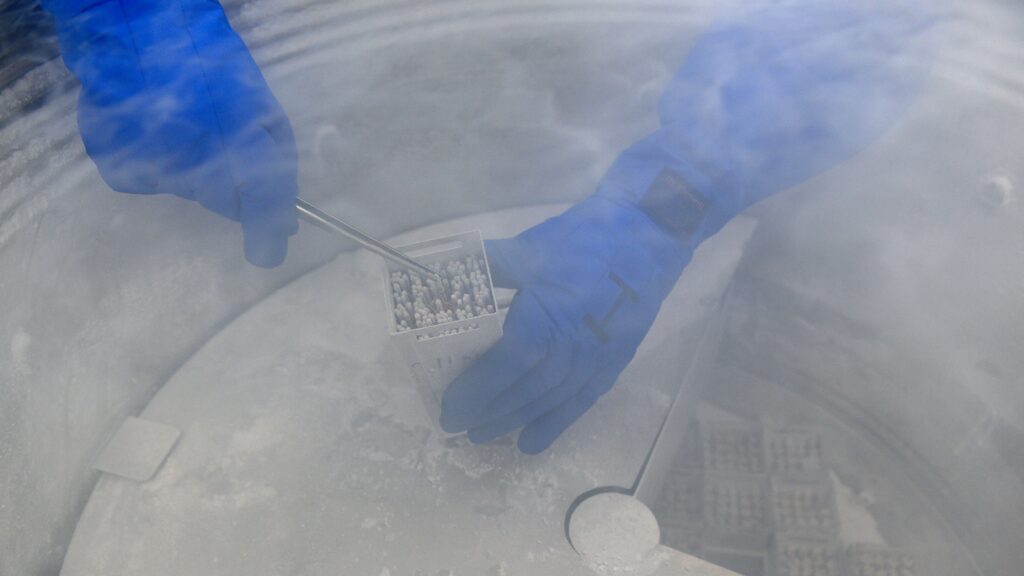Kindbody, a fast-growing fertility chain, knowingly exposed countless eggs and embryos to unsafe conditions and suffered repeated embryo mix-ups, according to a months-long Bloomberg investigation published recently.
Here we go again.
advertisement
Five years ago, a Pacific Fertility Center clinic in San Francisco suffered a massive storage tank failure that ended my dreams of ever becoming a mother. In all, 4,000 eggs and embryos from 400 people died that day in San Francisco.
At almost the same moment, another fertility clinic in Cleveland suffered a similar tank failure. After those twin disasters, the fertility industry claimed to have cleaned up its act. The recent Kindbody investigation shows that those reassurances were false. According to Bloomberg, “The company said its average incident rate across all clinics is 0.2%, which it says is similar to other leading US programs as detailed in a 2018 study by Boston IVF. It added that ‘no Kindbody laboratory has had an incident, accident or other issue that is unusual to what occurs in IVF laboratories generally.’” If what happened at KindBody was not “unusual,” that is an indictment of the industry.
The Food and Drug Administration regulates all treatments involving human cells and tissues but exempts fertility clinics. That loophole must be closed, and the agency must demand immediate improvements in egg and embryo storage practices.
advertisement
Eleven years ago, I made what I still believe to be one of the best decisions of my life by choosing to have my eggs retrieved and stored. I was 36, unmarried, and busy with a fulfilling career. I wanted children but not right then.
The procedure was remarkably successful. With 23 eggs safely stored, I suddenly felt freer and more unhitched to my biological clock. I dated differently and took more demanding jobs. No longer desperate to find Mr. Right, I was at my best, able to lose myself in the music of life.
Six years later, in 2018, I was at a conference in Texas when I got an email from Pacific Fertility saying that its storage tanks had malfunctioned. At the time, clinic administrators said they didn’t know whether my eggs were definitively ruined.
Soon after, I tried to have those eggs implanted only to learn definitively that none was viable. So several months later, I underwent several rounds of in vitro fertilization with newly retrieved eggs. But the success of IVF depends almost entirely on egg age. The ones taken from me when I was 36 might have developed into a baby. Those taken when I was in mid-40s didn’t.
I still sometimes wake up screaming, enraged that I will forever be childless.
According to a 2022 study, there have been at least nine major tank failures in the United States over the past 15 years that have affected more than 1,800 patients. One reason for this: A 2017 study said that some clinic administrators buy cheap cryo-storage tanks originally developed for cows, and they depend on manual protocols to safeguard patients’ most precious tissues.
And the process can go wrong in other ways, too. In even more cases, fertility clinics have accidentally switched specimens so that women gave birth to someone else’s baby.
Hundreds of lawsuits and tens of millions of dollars in damages have resulted. (I am not able to discuss any compensation I received or legal action I was part of.) But the industry remains flush with cash. Kindbody was recently valued at $1.8 billion. In 2022, KKR & Co. paid $3.2 billion for a chain of clinics in Spain. Clinic administrators routinely earn million-dollar salaries. In an industry swimming in money, scrimping on storage is unconscionable.
Unless something is done, egg destruction and mix-ups will only get worse as egg freezing volumes soar. In 2011, only one IVF procedure in four used frozen embryos. By 2020, three-quarters of procedures relied upon them. And the number of young women opting to undergo egg retrieval and long-term storage quintupled between 2014 and 2021.
There are roughly 500 fertility clinics in the United States, but according to Bloomberg, only a small number store eggs and embryos in systems that have been approved for the task by the FDA. These advanced systems use bar codes, remote monitoring, redundancies, RFID tags, and sophisticated tracking software to guard against tank failures and specimen mix-ups.
In place of these state-of-the-art systems, most clinics use freezers that are about as sophisticated as grocery store meat lockers. Specimens are given handwritten labels that often fade or fall off over time. These manual storage methods cannot safely handle the millions of specimens now present in IVF clinics.
The American Society for Reproductive Medicine’s leaders have long claimed that storage problems are rare. But the Kindbody investigation demonstrates that these problems are too numerous to ignore any longer.
I’m a great believer in young women taking charge of their fertility by getting their eggs retrieved and stored. But clinics and the federal government need to do a far better job making sure these eggs will be there when these women want to use them. Until they do, women undergoing fertility procedures must ask whether storage tanks are FDA-approved. Because no one should face the dark nights of anger and regrets that I still live through.
Monica Coakley is a marketing executive and lives in Los Angeles.

